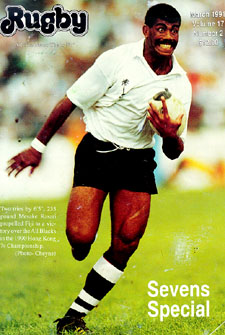 |
||
 |
||

Sevens: A guide for uninitiated Americans
Although most of this book presupposes a working knowledge of the laws, tactics and terminology of rugby, this chapter - - addressed to the typical American sports fan--is included with the hope that it will be useful to those looking to provide a description of the game of sevens to friends, spectators, potential recruits, etc.
Rugby sevens is a variation of rugby in which each team fields 7 players rather than the 15 players per team in standard rugby. As may be imagined, the fewer number of players produces a wide open game with lots of excitement and scoring.
Rugby is played with a ball similar, although not identical to, a football. The rugby ball is fatter and lighter, making it easier to kick but more difficult to pass; recently, however, new synthetic materials with roughened surfaces, have made one-handed passing of the rugby ball -- as in football -- much easier.
A full-sized rugby pitch is 75 yards wide, 110 yards between goal lines, with 25 yard deep end zones ("in goals," in rugby terminology). A schematic of a field is shown in Figure A2-1. (In true international traditional, rugby fields are really defined in meters, but the dimensions discussed here are the traditional ones and will do just fine for our purposes.)
Rugby goal posts are identical to football posts and are located on the goal line (as was once the custom in football itself).
The rules of rugby apply to sevens, but because of the difference in the number of players, different features of the game predominate in sevens. this description will concentrate on those features most characteristic of sevens.
Sevens is normally played in tournament, rather, than dual, competition, with individual games lasting only 14 to 20 minutes; with the intensity of the play, however, this is usually enough to fatigue the players. Recently, in the US, attempts have been made to incorporate substitutions and lengthen the game to make it suitable for two-team competition.
The object of sevens, as in football, is to cross the goal line with the ball. Unlike modern football, but like the football played at the beginning of the century, the ball must be "touched down" to score (and thus the term "touchdown" in football). The score is called a try, worth 4 points, because the team gets to "try" to convert the score into a "goal," worth 6 points, with a kick between the posts, as an extra point in football. If the ball is touched down near the sideline ("touchline"), the kicker must kick the conversion from the sidelines; if the scorer touches down between the posts, the kicker gets to convert from midfield.
The ball may be run, passed laterally, or kicked, at any time during play. Neither forward passing nor blocking are allowed. A tackled player brought to the ground must release the ball so that play may continue.
There are two other ways to score: a penalty kick from anywhere is worth 3 points, and a drop kick between the posts at any point in play is also worth 3 points. Because of the high rate of try scoring in sevens, neither penalty kicks nor drop kicks are common in this variety of the game.
The ball is put into play by one of the following: a kickoff, a scrum, a lineout, a drop out, a penalty kick or a free kick.
Kickoff. A kickoffs begins each game as well as the second half of each game. In addition, after each score, the team that did not score is required to kick off. As in football, the kickoff is taken from the halfway line, and is required to go 10 meters (11 yards). The long kickoff to the receiving team is a common option in 7s, but unlike football, the short "free kick," with the object of retaining possession for the kicking side, is the most frequent type of kick seen. With only 7 players to guard an area of more than 4000 square yards as opposed to 11 guarding only 2500 square yards in football--as well as the fact that there is no fair catch from the kickoff as in football, it not uncommon to see the kicking team winning its own kickoff.
Scrum. For minor infringements (such as unintentional forward passes or "knock ons" [ball dropped or knocked forward from hand or arm]), the ball is brought back into play with a scrum. The inside half back, the "scrum half" [equivalent of football's quarterback] puts the ball into the middle of the scrum, which is formed by the three forwards of each team making bodily contact with each other in a pseudo-wrestling formation. The center forward, the "hooker," attempts to strike, or "hook," the ball backwards for the scrum half to gather and pass the ball back to the outside half back, the "fly half," who, in conjunction with the center and wing, will attempt to use the ball creatively and effectively.
Lineout. Whenever the ball goes out of bounds ("in touch"), one of the players of the team that did not touch it last throws the ball into a line formed of two (occasionally three) players of each team. The ball must be thrown between the two teams, and the opposing players in the line (normally the prop forwards) contest possession. The ball is then normally distributed to the backs.
Dropout. As mentioned above, whenever the ball is touched down in goal (in the end zone) by a member of the attacking team, a try is scored. When the defending team touches it down, however, one of two things happen. If the defending team took the ball in, the attacking team is awarded a scrum at the 5-meter line (this is the rugby equivalent to football's safety); if the attacking team put the ball over the goal line, a drop out is awarded (the equivalent to the touchback). The defending team must get the ball over the 22-meter line with a drop kick, after which either team can recover it. Both long kicks, to gain territory, and short kicks, to retain the ball, are used.
Penalty kicks and free kicks. For a major infringement, a team is given a penalty kick or a free kick at the point of infringement. The defending team must retreat 10 meters. Penalty kicks, given for the most serious of these infringements, allow the team to kick directly for goal, whereas at a free kick the team may put the ball back into play but may not kick directly for goal. A goal kick from a penalty is worth 3 points and is roughly equivalent to football's field goal.
Maul. The one other formation that is often seen in sevens is the "maul," or standing tackle, when one or more players from each team is bound onto the ball carrier in a contest to maintain or seize possession. The referee will usually allow the maul to continue as long as the participants stay on their feet.
Open-field play. When the ball is moved into the open-field, sevens strategy often resembles that of basketball: the team with the ball may continually move the ball around, with active movement off the ball, probing the defense and hoping to get it moving the wrong way. The defense may be man-to- man, zone, or, more commonly, a combination of the two, similar to a "switching man" defense in basketball.
Sevens is a fast, high scoring event, and it is not uncommon for a try to be scored every three minutes, or even more frequently.
Above all, sevens is exciting, and a lot of fun to both play and watch.
Copyright 1999-2024
